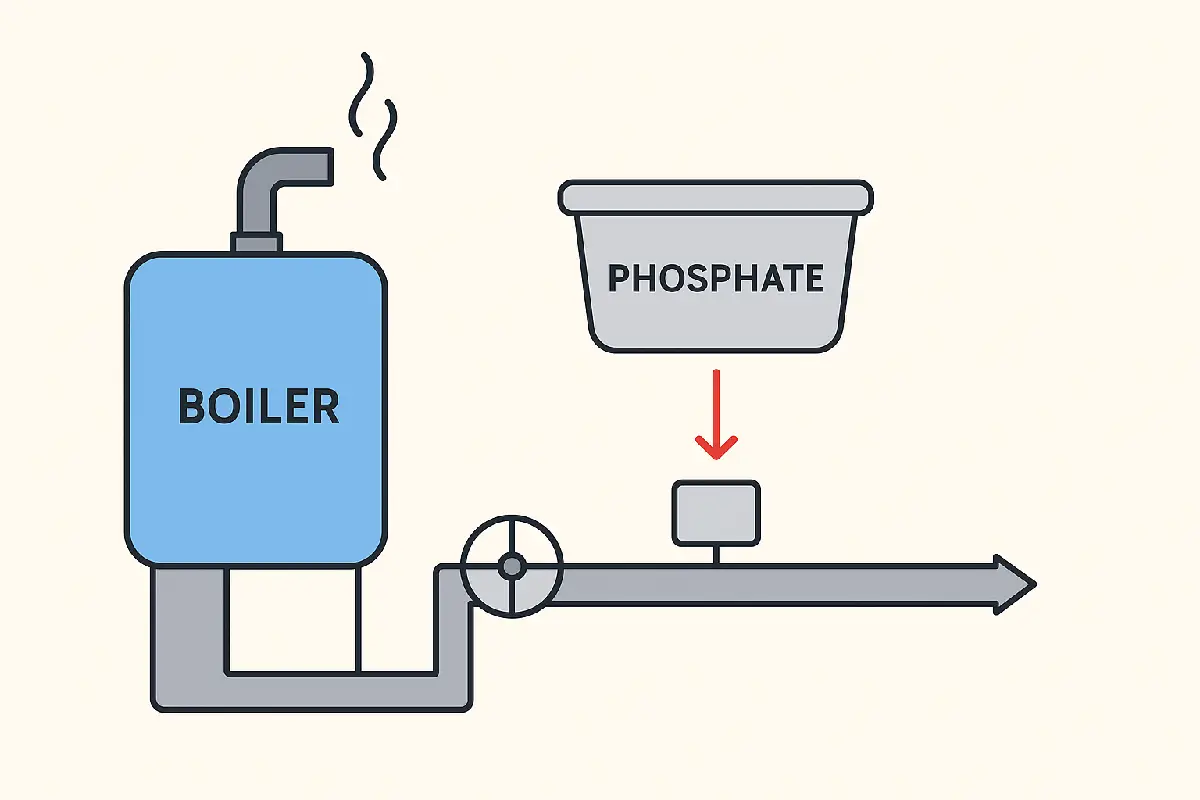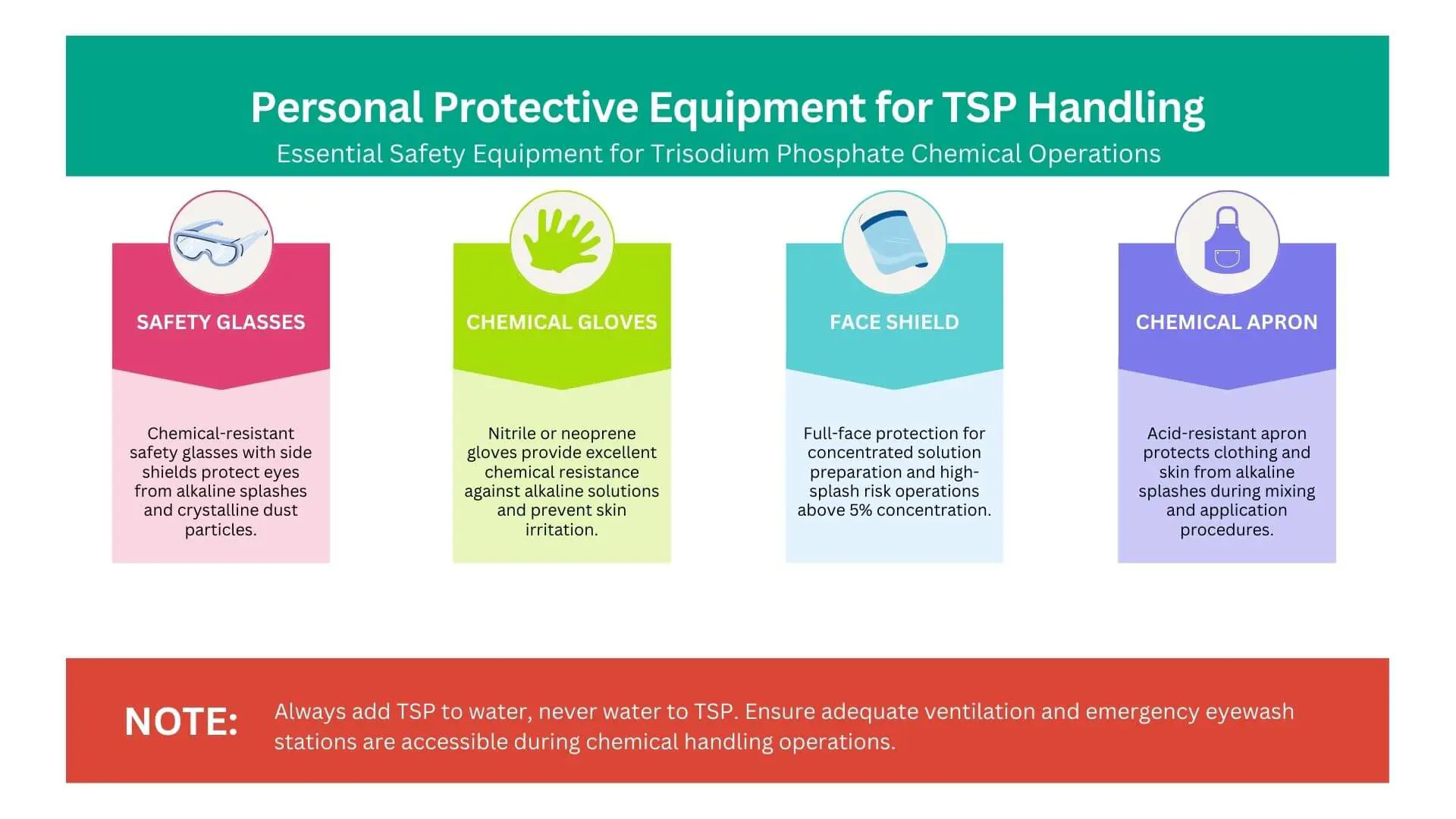Trisodium Phosphate is an inorganic chemical compound (Na₃PO₄). It is a white granular or crystalline material that can be mixed with water to create an alkaline solution. Once it is diluted, it is a very effective cleanser, degrease, and stain remover. Furthermore, trisodium phosphate is widely used in industrial chemistry. It plays a crucial role across multiple sectors. These sectors include water treatment, cleaning, food processing, and pharmaceuticals.
As trisodium phosphate is highly alkaline and versatile, it plays a major role in filling the gap between theoretical industrial chemistry and everyday industrial uses. In this easy guide, we will explain everything you need to know about trisodium phosphate. This includes its structure, properties, uses, and safety. We will also cover what to expect in the future as rules change. So, let’s get started.
Basic Structure and Properties of Trisodium Phosphate
Trisodium phosphate, with the molecular formula Na₃PO₄, belongs to the family of alkali metal phosphates. Its structure consists of three sodium ions (Na⁺) bonded to a phosphate ion (PO₄³⁻), creating a highly alkaline compound that’s the main reason to its industrial effectiveness.
1. Molecular Structure and Forms
Trisodium phosphate is most commonly found in two forms, anhydrous and dodecahydrate.
a. Anhydrous Trisodium Phosphate
Anhydrous TSP (Na₃PO₄) is the dry and pure form. It is a white, crystalline powder with no water molecules bound to it. Because it is a more concentrated form, it is often preferred for applications where a smaller volume of powder is needed.
b. Trisodium Phosphate Dodecahydrate
TSP Dodecahydrate (Na₃PO₄⋅12H2O) is the more common and hydrated form than anhydrous trisodium phosphate. It has 12 water molecules for every one molecule of TSP. This form is also white, and crystalline solid, but its water content makes it slightly less concentrated by weight.
Let’s compare both of these forms:
| Property | Anhydrous TSP | Dodecahydrate TSP |
|---|---|---|
| Water Content | 0% | 45.2% |
| Solubility (20°C) | 12 g/100mL | 28 g/100mL |
| pH (1% solution) | 12.0 | 11.5 |
| Storage Stability | Higher | Moderate |
| Cost Efficiency | Lower volume | Higher bulk |
| Use Case | Where concentration and low volume are critical | General-purpose industrial applications |
2. Physical Properties
As you already know, when trisodium phosphate is dissolved in water, it becomes highly alkaline in nature. Their solubility is temperature dependent, with their ability to dissolve in water increasing as temperature increases. This property makes them particularly valuable in hot water treatment applications and boiler water treatment systems where higher temperatures increase their effectiveness. We recommend “Boiler Water Treatment, Principles and Practice” a practical guide for engineers dealing with phosphate dosing in boilers.
Grades and Specifications
The quality and purity of trisodium phosphate can vary widely depending on its intended use. Different industrial applications need specific purity levels and properties, leading to separate grades with carefully controlled specifications.
1. Food-Grade TSP
Food grade TSP is very pure and safe for use with food. It is known as the food additive E339 and follows the rules of the FDA and global food safety guidelines. This type usually contains less than 0.003% heavy metals and has stable levels of phosphate.
2. Technical-Grade TSP
This is the most common grade for industrial applications, such as cleaning and water treatment. While it may contain minor impurities like sodium carbonate, these do not affect its performance in non-food applications.
3. Pharmaceutical-Grade TSP
Pharmaceutical-grade TSP is the purest type and is used as a helper in making drugs. This grade is tested carefully for any impurities and follows very strict quality rules.
A buyer’s checklist should always have these details to make sure the right product is bought.
| Specification | Technical-Grade (Typical) | Food-Grade (Typical) |
|---|---|---|
| Assay % (Na₃PO₄) | 98% (min) | 99% (min) |
| pH (1% soln.) | 11.5 – 12.5 | 11.5 – 12.5 |
| Solubility | Readily soluble | Readily soluble |
| Heavy Metals | Trace amounts accepted | Below regulatory limits |
| Form | Anhydrous or Dodecahydrate | Anhydrous or Dodecahydrate |
Industrial Applications of Trisodium Phosphate
The versatile nature of TSP means it is widely used in many areas. Its ability to regulate pH and break down organic matter makes it an important chemical for many industrial processes. Let’s explore some of its most important applications.
1. Trisodium Phosphate in Water Treatment and Boiler Chemistry
In boiler systems, scaling and corrosion are constant challenges. TSP acts as a buffering agent and corrosion inhibitor by maintaining alkalinity and preventing acid attack on boiler metal surfaces.
- Buffering capacity: Keeps water pH in the 10–11 range, reducing risk of corrosion.
- Scale control: Reacts with calcium and magnesium to form sludge that can be blown down instead of forming hard deposits.

Example: Boiler Dosing Calculation
If a boiler requires 30 ppm phosphate, and you have a 100,000-liter system, the required TSP dosage can be calculated as:
Dosage (kg) = (30 ppm × 100,000 L) / 1,000,000 = 3 kg
2. Industrial & Household Cleaning
TSP is known as a strong cleaner because it can break down dirt and dissolve oils. It is an alkaline cleaner that helps dissolve grease and oil and spreads well on surfaces.
Concentration Guidelines for Cleaning Applications:
- Light cleaning: 1-2 tablespoons per gallon (0.5-1%)
- Heavy degreasing: 4-6 tablespoons per gallon (2-3%)
- Paint preparation: 1/2 cup per gallon (4-6%)
TSP is great for preparing surfaces for painting because it helps remove grease, wax, and mildew while also helping paint adhere better by roughening the surface slightly. For smaller-scale use, many professionals rely on Trisodium Phosphate Cleaner on Amazon to achieve strong degreasing results.
3. Food & Pharmaceutical Uses
Beyond its industrial applications, TSP also has a place in the food and pharmaceutical industries. As the food additive E339, it acts as an emulsifier, thickening agent, and pH adjusting agent in processed foods. For example, it is used to prevent cocoa powder from caking in powdered drink mixes and to maintain the texture of processed cheese. In pharmaceuticals, it acts as an excipient, an inactive ingredient that helps in the formulation of medications.
Some may ask, “Is trisodium phosphate safe to eat?” The FDA and other regulatory agencies have deemed food-grade TSP safe for use at approved levels. The myth about TSP being harmful in food often comes from confusion with its industrial-grade counterpart.
4. Other Uses of Trisodium Phosphate in Industrial Chemistry
TSP’s versatility extends to several other industries also, like:
- Textiles: Used in dyeing and printing processes to help dyes penetrate and bond with fabrics.
- Metal finishing: Acts as a cleaning and degreasing agent to prepare metal surfaces for plating or coating.
- Poultry processing: Applied as a microbial decontamination rinse for poultry carcasses.
Safe Handling and Usage of Trisodium Phosphate in Industry
Trisodium phosphate requires caution in handling, as it has a high alkalinity that can be hazardous. It is important for anyone working with the chemical to understand safety protocols.
- PPE Recommendations: Always wear the correct personal protective equipment (PPE), such as safety glasses, chemical-resistant gloves, and a dust mask. If you are mixing or handling a large amount of chemicals, also wear a face shield and a chemical-resistant apron.
- Mixing/Dilution Order: Always add TSP powder slowly to the water while stirring to avoid heat or clumping. Never add water to the powder. This is an important safety rule for mixing strong alkaline solutions.
- Storage Stability: TSP is stable under normal conditions, but store it in a cool, dry place. Make sure containers are tightly closed to prevent moisture from getting in, as TSP can clump and become difficult to use.
- Incompatibilities: TSP does not mix well with strong acids, as it can react violently. It can also damage some metals, such as aluminum, and can react with ammonium salts to release ammonia gas. So, always use protective gear such as chemical-resistant safety gloves when handling TSP in any form.

Environmental and Regulatory Impacts of Trisodium Phosphate in Industrial Chemistry
The rules on phosphate compounds have changed a lot in the past few years due to concerns about water pollution. Many places now have limits on how much phosphate can be discharged from factories.
1. Regional Phosphate Regulations
a. United States:
The EPA has rules regarding phosphate releases under the Clean Water Act, with different laws for each state. Some states have completely banned cleaning products that contain phosphates.
b. Asia-Pacific:
Countries like Japan and South Korea have strict restrictions on phosphate emissions. Other countries in the region are beginning to enact similar laws.
C. European Union:
The European Union has strict rules on phosphates in detergents and industrial cleaners, pushing for more environmentally friendly options.
2. Sustainable Alternatives
Industries are considering alternatives such as sodium metasilicate, STPP, and citrate-based compounds. These are better for the environment and can also clean up phosphates. However, TSP is still necessary for some applications because it has unique properties that can’t be matched by alternatives.
Procurement and Economics of Trisodium Phosphate in Industrial Chemistry
The price of TSP is primarily determined by the price of phosphoric acid, which accounts for approximately 60-70% of the production cost. The energy costs for making and drying TSP, along with shipping costs, also affect the final price.
The global market for phosphoric acid can be volatile due to raw material availability and environmental changes, which also cause TSP prices to fluctuate.
Packaging and Logistics
Common Packaging Formats:
- 50-pound bags for small-scale users
- 2,000-pound supersacks for medium industrial applications
- Bulk rail cars for large-scale industrial consumers
Choosing the right packaging helps save money and makes it easier to handle. Buying in bulk usually saves 15-20% but needs good storage and handling tools.
Quality Assurance Checklist
When procuring TSP, verify:
- Certificate of analysis matching your specifications
- Proper packaging integrity and labeling
- Supplier’s quality management certification
- Traceability documentation for regulated applications
Building relationships with verified suppliers ensures good quality and compliance with regulations, which is especially important for health and medicine.
Mini-SOPs: Practical TSP Industrial Applications
Here are some standard operating procedures (SOPs) for common industrial uses, showcasing the practical application of TSP.
1. Paint Preparation Degreasing
Concentration: 4-6% solution (1/2 cup per gallon)
Procedure: Apply solution to surface using brush or sponge. Allow 10-15 minutes contact time. Scrub stubborn areas with nylon brush. Rinse thoroughly with clean water and allow complete drying before painting.
Safety Note: Make sure adequate ventilation and wear appropriate PPE during application.
2. Boiler Water Phosphate Dosing
Target Range: 30-100 ppm phosphate residual
Procedure: Calculate required TSP quantity based on system volume and target concentration. Dissolve TSP in makeup water before system introduction. Monitor phosphate levels every 4-8 hours initially, adjusting dosing as needed. Maintain proper blowdown schedule to prevent phosphate buildup.
Quality Control: Test phosphate residuals using orthophosphate test kits calibrated for your specific conditions.
3. CIP Cleaning in Food Plants
Concentration: 0.5-2% depending on soil load
Temperature: 120-140°F for optimal performance
Procedure: Pre-rinse system with potable water. Circulate TSP solution for 15-30 minutes at target temperature and concentration. Post-rinse with potable water until neutral pH achieved. Sanitize according to plant protocols.
Documentation: Maintain cleaning logs showing concentrations, temperatures, and contact times for regulatory compliance.
4. Poultry Processing Rinse
Concentration: 8-12% solution for carcass washing
Application: Spray or dip application with 15-45 second contact time
Rinse Protocol: Thorough potable water rinse following TSP treatment
Monitoring: Verify absence of TSP residue through pH testing of final rinse water
5. Metal Finishing Bath Preparation
Concentration: 2-8% based on contamination level
Temperature: Ambient to 140°F depending on application
Process: Immerse parts for 5-20 minutes with agitation. Remove and inspect for cleanliness. Rinse with DI water and dry promptly to prevent flash corrosion.
Quality Check: Water break test confirms adequate surface preparation for following coating processes.
Future Outlook for Trisodium Phosphate in Industrial Chemistry
The industrial chemistry landscape is evolving with sustainability driving innovation in phosphate alternatives. However, TSP’s unique properties ensure its continued relevance in specialized applications where performance requirements outweigh environmental concerns.
Sustainable Phosphate Alternatives
Researchers are developing bio-based alternatives and advanced surfactant systems that can match TSP’s performance in specific applications. Enzyme-based cleaners show promise for replacing TSP in most of the daily routine applications. In water treatment uses, advanced silicate compounds may be an alternative.
The primary challenge lies in replicating TSP’s exceptional buffering capacity and multifunctional performance in a single alternative compound.
Regulatory Evolution
Future regulations will likely focus on phosphate recovery and recycling rather than outright bans. Technologies for phosphate reclamation from wastewater streams are becoming economically possible, potentially creating circular economy opportunities for TSP users.
We would say industries must balance regulatory compliance with operational requirements, often requiring hybrid approaches that combine TSP for critical applications with alternatives where possible.
Market Adaptation
The Trisodium Phosphate market is adapting product specialization and application-specific formulations. Manufacturers are developing improved grades with improved environmental profiles while maintaining performance characteristics essential for industrial applications.
This evolution suggests that Trisodium Phosphate will stay relevant but increasingly targeted toward applications where its unique properties offer irreplaceable value.
Conclusion
Trisodium phosphate’s enduring presence in industrial chemistry shows its remarkable versatility and performance across different applications. From maintaining boiler efficiency to ensuring food safety, TSP continues bridging the gap between theoretical chemistry and practical industrial solutions.
Understanding TSP’s properties, applications, and safety requirements empowers professionals to make informed decisions about its use while maintaining compliance with evolving regulations. Whether you’re specifying water treatment chemicals or selecting cleaning agents for industrial applications, this knowledge is essential. It forms the foundation for successful implementation.
The future may bring new alternatives and better regulations. However, trisodium phosphate has a proven track record that ensures its continued importance in industrial chemistry. By combining this knowledge with emerging technologies and sustainable practices, industries can improve TSP use while minimizing environmental impact.
We encourage you to share your experiences with TSP applications or ask questions about specific use cases. Your insights help build our community’s collective understanding of industrial chemistry applications.
Recommended Reads for Curious Minds
To learn more about industrial chemicals, check out these helpful resources.
1. Advanced Technologies in Wastewater Treatment: Food Processing Industry
This book explores cutting-edge wastewater treatment methods for the food processing industry. It covers oxidative and anaerobic processes, membrane operations, and ion exchange. The book also discusses advanced biological systems aimed at producing clean water and recovering valuable resources.
Check it out here: Advanced Technologies in Wastewater Treatment: Food Processing Industry
2. Food Additives Data Book
“Food Additives Data Book” by Smith & Hong – A detailed guide on TSP’s uses in food, rules to follow, and safety tips for people working in the food industry.
Check it out here: Food Additives Data Book
3. Handbook of Industrial Chemistry and Biotechnology
Comprehensive resource on industrial chemicals, including phosphates.
Check it out here: Handbook of Industrial Chemistry and Biotechnology
Frequently Asked Questions
No, sugar soap typically contains sodium carbonate as the primary alkaline ingredient, while TSP is pure trisodium phosphate. Sugar soap is generally milder and designed for painted surfaces.
Yes, food-grade trisodium phosphate (E339) is considered safe by regulatory departments like FDA when used within approved limits. It is a very different grade from the industrial-grade TSP that is used for cleaning.
TSP was not completely banned, but its use in many household detergents and cleaners was limited in some areas because of environmental worries about phosphate runoff causing water pollution.
Tripotassium phosphate is used in some cereals to control acidity and help mix ingredients. Although it is different from TSP, it is part of the same group of phosphate salts and works similarly in food processing to keep texture and quality consistent.
Yes, trisodium phosphate remains available for professional and consumer applications. However many consumer cleaning products have switched to phosphate-free alternatives due to environmental regulations.




